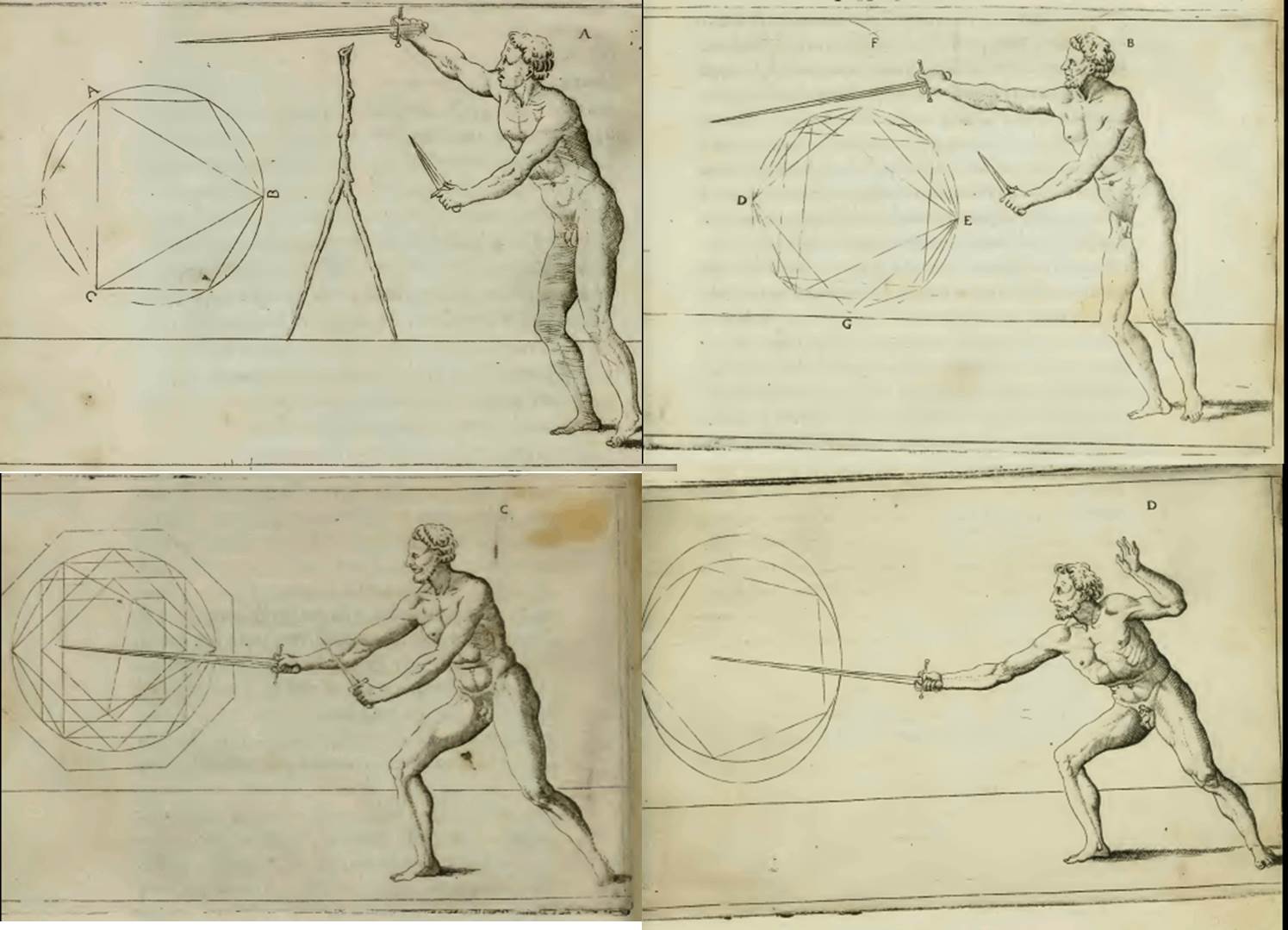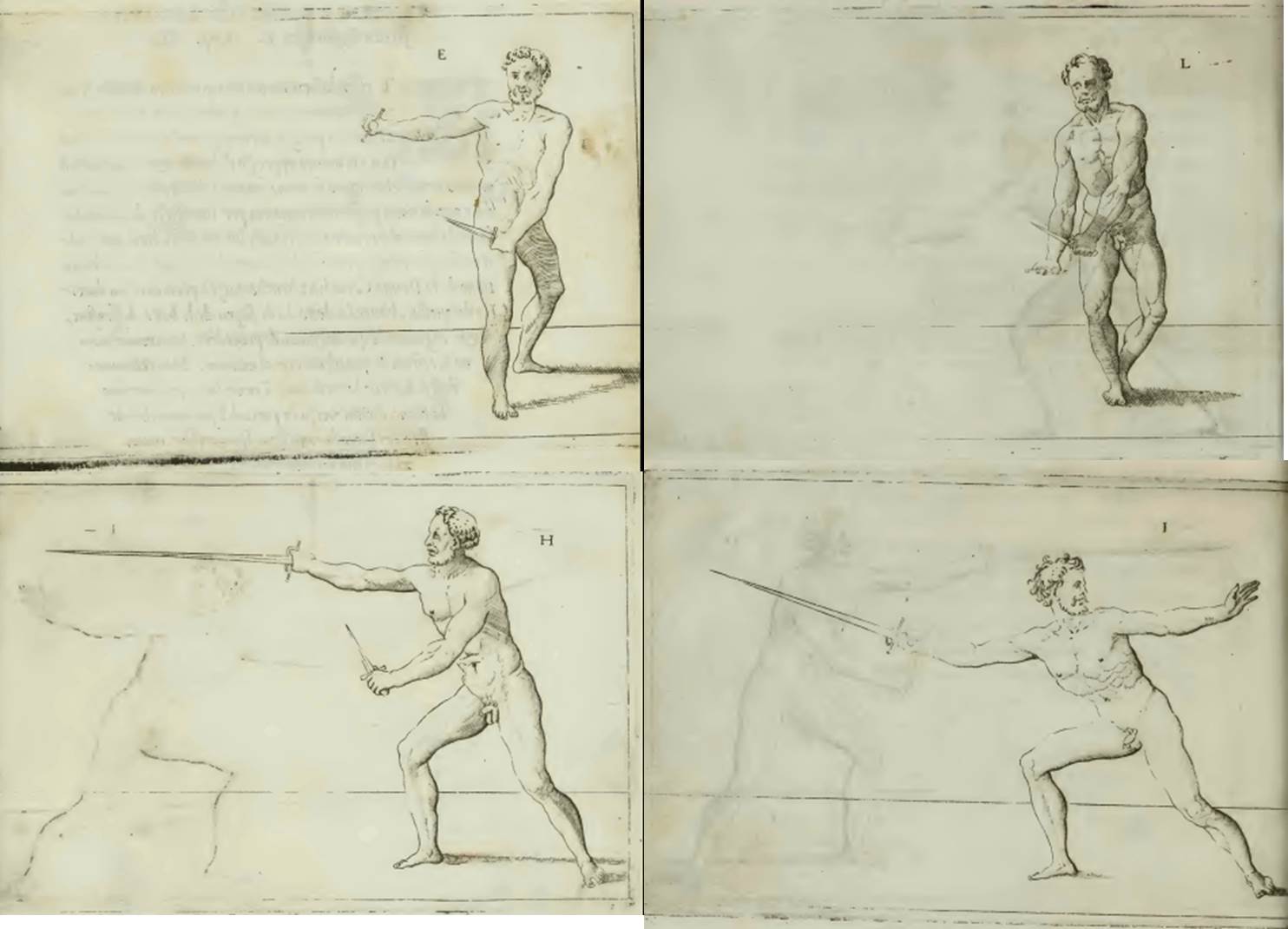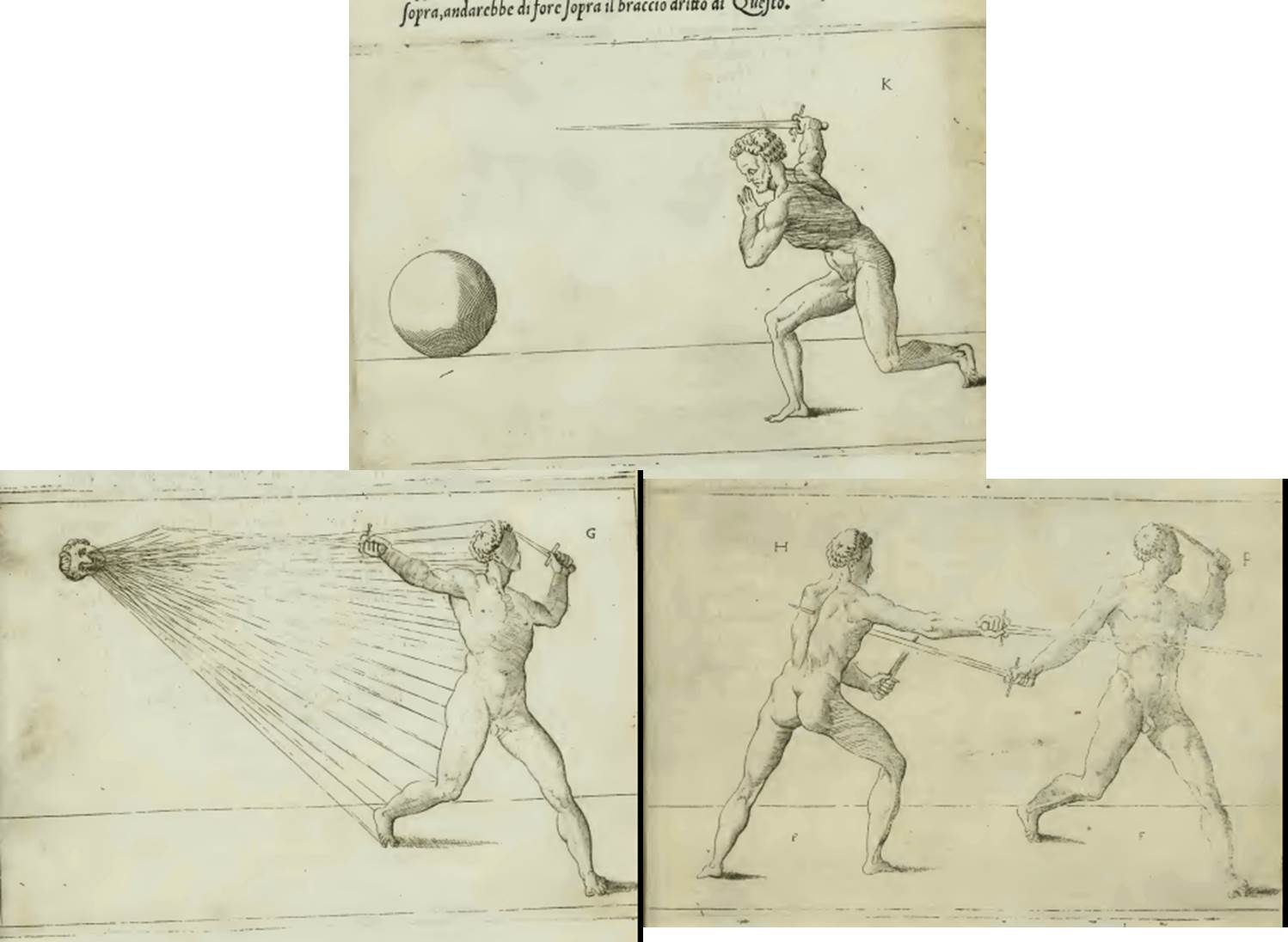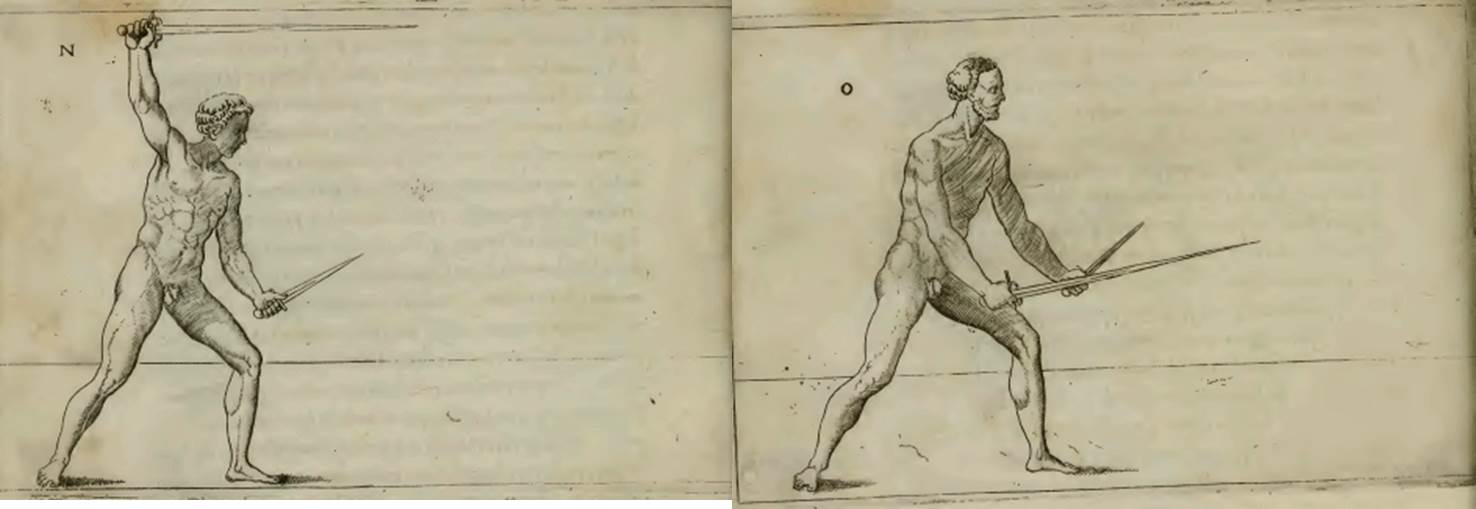I recently finished reading Ken Mondschein’s Fencing: A Renaissance Treatise, which is a translation of Camillo Agrippa’s Treatise on the Science of Arms with Philosophical Dialogue, published in 1553. As someone who is most accustomed to the writing styles of the later Italian rapier treatises, I found Agrippa’s approach somewhat difficult to understand at first. Giganti, Capo Ferro, and Fabris begin with an introduction that describes the core principles of their combat system and then they provide examples (the plays) of how to apply those principles. In contrast, Agrippa primarily explains the principles of his system using examples. This approach is far less explicit and relies on the reader to make inferences based on the actions provided. In this, Agrippa seems to be rather similar to most of the other historic fencing treatises that I have read, suggesting that either the Italian rapier treatises are unique in their level of explicit discussion of fencing principles or that the fencing principles underlying Italian rapier are more complex/developed than manuals that were written earlier. In any case, the result is that understanding Agrippa requires that we delve into the guards, motions, and plays in order to understand the principles.
This may contribute to why Agrippa seems to be relatively rare amongst SCA fencers. Despite the fact that Agrippa is a thrust-oriented system of combat, and should fit relatively well into the heavy rapier rules, I have met far more fencers who studied cut-oriented systems and attempted to adapt them to the heavy rapier field. Indeed, I have met only one fencer who sought to learn to fence like Agrippa over the course of several years of active involvement in the SCA. In contrast, it seems like everybody and their cousin is “fencing Giganti” or “doing Capo Ferro” these days. While certainly some of the relative popularity of Italian rapier is due to people like Dante who have spent lots of time teaching and instructing in the Italian rapier systems, I suspect that the lack of explicit principles in the text makes Agrippa seem more daunting to new students who might prefer something that is more easily chewed.
Differences in the approach taken by the modern translations may actually compound this problem. If we compare the Tom Leoni translations of the Italian rapier systems with Mondschein’s translation of Agrippa, we will notice that where Leoni provides a relatively straightforward tutorial to the basic actions and core principles of the manual, Mondschein instead provides an academic discussion of the historic context of the manuscript. While I thoroughly enjoyed Mondschein’s introduction, it certainly does not make it easier for a beginner to pick up Agrippa and learn to fence. To that end I am hoping to provide such a tutorial here over the course of several posts.
Approaching Agrippa:
As noted above, understanding Agrippa requires that we work from examples and use those to infer not only the core principles of the system, but also rather basic concepts such as how to move. In order to do this, it is important that we understand two key concepts. First, we must understand that fencing is a combinatorics problem. Combinatorics is the study of finite sets, and we can use combinatorics in order to solve problems by identifying all of the possibilities and then either identifying good solutions from that set or by eliminating bad ones. It should be apparent from a cursory reading of Agrippa’s manual that he provides a finite (and relatively small) set of positions (labeled A, B, C, …) and a finite set of actions (the plays). Second, we must understand the concept of degrees-of-freedom. In this context, a degree-of-freedom is a place where a system can vary.
It should be obvious that fencing is intended to be carried out using the human body, but it may be less obvious that the human body has a finite number of degrees-of-freedom. That is, each joint in the body is a single degree of freedom and, at each joint, it is only possible to move in 1-2 ways (extension/flexion, rotation, adduction/abduction, elevation/depression, extension/retraction). Based on these two concepts, we can see that there are a finite (but large) number of ways to position the body and that there is a finite (but small) number of positions that are used by Agrippa. However, it isn’t particularly efficient for us to address the thousands of possible ways to position the body, and clearly some of those will be ridiculous ways to stand for fencing. Recall that a degree-of-freedom is a place where a system can vary, so rather than using all of the possible ways of moving the body as our system, we can further restrict the system by looking at the positions provided by Agrippa.
Fortunately Agrippa gives us relatively few positions to consider. He provides us with 4 basic guards, 3 alternative guards, 3 voids, 2 “lunges”, and 2 left-foot forward stances in his explanation of the single sword for a total of 14 different positions. Because a degree-of-freedom is a place where a system can vary, we first should identify similarities between the positions provided by Agrippa. Let us first limit ourselves to considering the four basic guards provided by Agrippa, A, B, C, and D. For now, we will hold off on discussing the use of the dagger in the left hand and will focus on how the body and sword arm are held.
Basic Guards:
Similarities:
- Right foot is forward
- Weight is on the front (right) foot
- Right leg is bent
- Body held upright with lean forward
- Body is profiled, with right shoulder forward
- Back is straight
- Sword held pointing towards opponent
Degrees-of-Freedom:
Guard:
Because these four plates are intended to show us the difference between the four guards, it follows that we should consider guard to be our first degree-of-freedom. These guards are named first, second, third, and fourth and differ specifically in the rotation of the forearm. It is worth noting that these “basic” guards vary in more ways than just guard.
- A: prima (first) – True edge up, palm to the right (outside), hand slightly above the shoulder
- B: seconda (second) – True edge to the right (outside), palm facing down
- C: terza (terza) – True edge facing down, palm to the left (inside)
- D: quarta (fourth) – True edge facing to the left (inside), palm facing up
Those of you who study Italian rapier will recognize this naming scheme and the basic guards, however, I will point out that they seem to differ in one important way, namely that the quarta is held to the inside of the right knee.
Stance:
The second degree-of-freedom we can see in these plates is a difference in stance. Simply put, the basic guard for first (A) and second (B) occurs using a narrow stance while the basic guard for third (C) and fourth (D) uses a wide stance.
If you have been paying attention you will note that these two degrees of freedom provide us with 4 guards x 2 stances = 8 possible positions, so there are 4 possibilities that we have not yet addressed. Agrippa addresses two of these possibilities, first and second with a wide stance, in chapters 4 and 5 respectively, noting that by being in a narrow stance, you gain additional reach over your opponent without putting yourself at additional risk due to the strength of the guard. In other words, both narrow and wide stances are safe while in first or second, but a narrow stance gives you more reach and is therefore better. The narrow third is shown in position F by Agrippa, however there is no explicit explanation for the absence of a narrow fourth position. However, Agrippa does note that in the fourth guard, the fencer must be more cautious, suggesting that it is less safe. Combined with what was said about using narrow stance in first and second, we might conclude that Agrippa considers a narrow quarta to be unsafe as, it leaves the head relatively unprotected from high attacks. Therefore, using only 2 degrees-of-freedom, we can define 5/14 positions described by Agrippa.
Additional Positions:
Sword Position:
Now, if we wanted to describe the rest of the positions in Agrippa, we would need to add degrees-of-freedom, so let us next consider the four positions E, L, H, I. If we compare these stances against each other and with the basic guards, we can see that there are different ways of positioning the sword. H and I show the sword extended in wide second and wide quarta respectively by extending the arm at shoulder level. While Agrippa does not use the term “lunge” these positions are the closest to the lunge that we are familiar with and Agrippa seems to use them in that manner. In contrast, E and L show the sword retracted in narrow second and third respectively. Agrippa specifies that he purpose of these positions is to deny your opponent access to your sword. Finally, our basic guards A,B,C, and D, as well as F show the sword in a “neutral” position. This means that we have an additional sword position degree of freedom, and using these 3 degrees-of-freedom, we can describe 9/14 of Agrippa’s positions.
However, we have even more possibilities that Agrippa has chosen not to include. You may have noticed, for instance, that there is no explicitly extended nor retracted prima. However, if you form A, you’ll find that it isn’t really possible to extend the arm any further. At the same time, Agrippa’s description of A given in chapter 4 notes that the forward position of the sword is important because it allows you to defend yourself with the strong part of the sword (near the hand). This would not be the case if you were to stand in a retracted prima. We also may note that position N involves a retracted prima albeit while placing the left foot forward.
Based on what we have already concluded using the guard and stance degrees of freedom, the only missing positions are an extended wide third, an extended narrow third, a retracted wide third, a retracted wide quarta, and we might likewise be surprised by the existence of an extended wide second (H). In chapter 6, Agrippa suggests a strike in wide third carried out by pushing the front foot forward to a wider stance, however, we might conclude that this particular strike is suggesting a thrust from below in C. This “lunging” action might then describe a transition from F to C for instance. The lack of an extended narrow third and the presence of an extended wide second may actually occur for the same reason that it is safe to use a narrow stance in first (A) and second (B) . In chapters 4 and 5, Agrippa notes that it is safe to use a narrow stance in first and second because those guards cover the head. However, in H, the extended arm is actually lower than it is shown in B, which may mean that the head is left uncovered. If this is the case, then we would also expect that an extended narrow third also leaves the head uncovered.
Agrippa does not explain the absence of a retracted wide third, however, chapter 16 specifies the use of L as a method of convincing your opponent to close distance. If you were to do the same thing in a wide stance, you would find that these gains would be negated, as the distance you can extend yourself forward is dictated by the placement of the left foot (Consider a transition from L to H or I, for instance). Finally we must explain the absence of a retracted quarta. This is relatively easy to explain, as, if one were to go into quarta (D) and attempt to retract your arm in quarta (mirroring E), you will find that the sword arm crosses the body rather awkwardly.
The last 5 positions that Agrippa gives us can be divided into a set of 3 voids and a pair of positions with the left foot forward. We can therefore fully describe these using only two more degrees-of-freedom, namely the Alignment of the stance (in-line, off-line to the outside, off-line to the inside) and the Front Foot (left vs. right).
Alignment:
Agrippa presents us with 3 voids, G, K, and P. Both G and P are voids of the inside line performed by stepping towards the outside with the right foot. They differ from each other only in the position of the sword, with G delivering a high thrust (extended) and P delivering a low thrust (neutral) (Book 2 chapter 9). Agrippa specifies that it is best to perform G in second rather than in third, but also discusses performing G using fourth in chapter 11. It seems that P can be used similarly, and Agrippa does say that it is identical in Book 2 chapter 9. K is instead a void of the outside line. It seems to be performed by stepping off-line to the left with the right foot, by lowering the body, and by twisting the body clock-wise. The sword is held in a retracted second (like in E). Interestingly, Agrippa’s description of K in chapters 14 and 23 suggest that this is not performed in opposition, but rather that the opponent’s weapon will pass between your sword and your head. Indeed, all 3 voids seem to occur without blade opposition.
In these three cases, the important aspect seems to be the step off-line and Agrippa seems somewhat ambivalent in his advice about which guard to use. If we consider our other degrees of freedom, we’ll see that all 3 of these occur in a wide stance. In fact, Agrippa seems to prefer striking the opponent using a wide stance, as he does so in C, H, and I, and only strikes the opponent in a narrow stance in A where he states that forming a narrow stance provides additional reach (chapter 4). If we consider position of the sword, we can see that G and P include both the extended and retracted positions respectively, however there is only a retracted form of void of the outside (K). However, if we consider that the opponent’s weapon is supposed to pass between the weapon and our head, then we will note that an extended guard would not allow this as the sword would be in front of rather than to the right of the body.
Front Foot:
Finally, Agrippa provides us with two positions shown with the left foot forward, N and O. You will note that these guards both use a wide stance, but only use a retracted first and neutral third guard. Agrippa is far less clear about the usage of the left-foot forward guards and suggests that they are useful for some limited and explicit situations. As such, it is hard to see a reason why these are the only guards depicted by reading chapters 25-28 which describe these positions. In chapter 28 (which describes O), Agrippa suggests that by taking a wide stance we can avoid the need to parry feints to the front leg, which I assume suggests that he intends to void the front leg either by moving to a narrow stance or performing a full traverse back to a right-foot-forward stance. We also might take note that there is relatively little practical difference between right-foot-forward and left-foot-forward in a narrow stance, and so Agrippa may have not felt it necessary to discuss (or to even assume a narrow left-foot-forward guard). The absence of a second guard is a little more obvious, as with the left foot forward, second provides little protection for the left side of the body. This is likely also the reason for the retracted, rather than neutral, prima guard shown in N. It is also apparent that a left-foot-forward quarta becomes awkward, as we would be turning the sword in towards the body.
References:
Ken Mondschein, ed. Fencing: A Renaissance Treatise by Camillo Agrippa. New York: Italica Press, 2009. 234pp.
Images copied from an electronic copy of an original manuscript held in the collection of the Getty Research Institute. Accessed from: https://archive.org/details/trattatodiscient00agri on September 5, 2015.





Pingback: Dante di Pietro
Pingback: Gawin
Pingback: Agrippa part deux: Movement « The Weekly Warfare